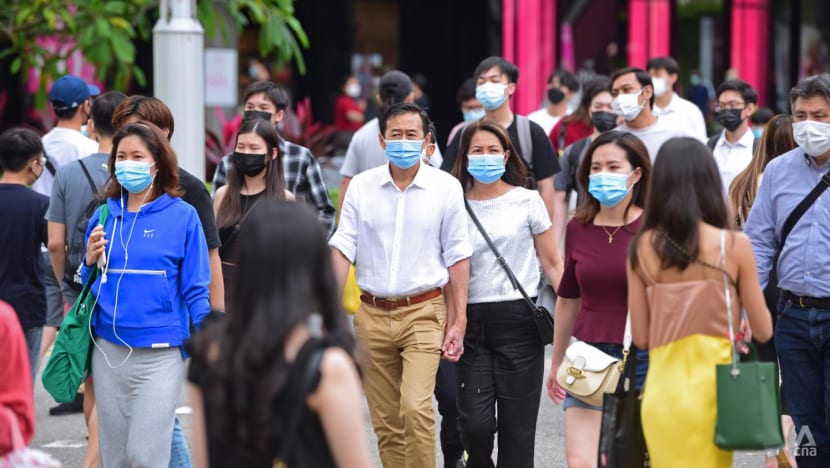'Possible' to live with Omicron as severe cases remain low despite surge: Ong Ye Kung

People wearing protective face masks in Orchard in Singapore on Jan 5, 2022. (Photo: CNA/Gaya Chandramohan)
SINGAPORE: It is “possible” to live with the Omicron variant of COVID-19, as the number of cases with severe outcomes remain low despite the surge in cases, said Health Minister Ong Ye Kung on Tuesday (Feb 8).
Speaking at the Singapore Health Quality Service Awards 2022, Mr Ong thanked healthcare workers for their efforts amid the COVID-19 pandemic.
Adding that the Ministry of Health (MOH) will monitor the trajectory of the transmission wave closely, he noted that “every country will experience and even shape the curve of their transmission wave”.
The wave could rise sharply and come crashing down in a few weeks such as in South Africa and Australia, or it could remain moderately high for slightly longer like in the Netherlands or Denmark, he added.
“We are trying to co-exist with a force of nature, with measures that we have put in place such as restrained social behaviours and vaccinations. No one knows exactly what the impact of these measures will be, what the final trend line will look like, and what is on the other side of Omicron,” said the Health Minister.
“But it is however comforting and encouraging is that among patients infected, the number of cases with severe clinical outcomes remains low despite the sharp surge in cases. This means it is possible to live with Omicron.”
The current Omicron wave is registering daily cases a few times more than that of the Delta wave “as expected”, and the numbers may go up even more, said Mr Ong.
“Fortunately, as we have envisaged as well, it is also a less clinically severe variant compared to the Delta variant.”
At the peak of the Delta wave, Singapore had about 3,200 daily cases with about 170 beds in the intensive care units occupied by COVID-19 patients.
Now, with more than three times the number of daily cases, there are about 20 COVID-19 patients in the ICU, said Mr Ong.
“While our healthcare workers are very busy, stretched, stressed, I think it is a different level of intensity as compared to during the Delta wave.”
However, a large number of daily infection cases is “still a significant threat”, and there are still severe cases that need care, he added.
MORE CHILDREN INFECTED
While hospitals may not be stressed “in the same way” as during the Delta wave, Singapore needs to ensure that there are sufficient paediatric beds because the Omicron variant is more likely to infect children than the Delta variant, said Mr Ong.
Children aged five to 11 currently have the highest infection rate at about 67 per 100,000, followed by those aged 12 to 19, with an infection rate of about 55 per 100,000.
“This is quite different compared to during the Delta variant wave, which mostly infected older and working adults. With more children and young people getting infected, severe cases are inevitable, and we need to ensure that there are sufficient beds for them,” said Mr Ong.
Public and private hospitals are setting up more beds for children, and COVID-19 treatment facilities are also converting more beds for children and their caregivers, he added.
“Fortunately, children admission to hospitals and CTFs due to COVID-19 are often precautionary in nature, with short stays of about two to three days. Notwithstanding, it is important to get them vaccinated to protect them against the risk of severe illness should they get infected.”
Vaccination against COVID-19 and boosters continue to make a “significant difference” to the outcomes of those infected, said Mr Ong.
Of Omicron patients, 0.3 per cent need oxygen supplementation or ICU care, he noted. This figure is 1.8 per cent among seniors aged 60 and above.
However, there was “a big variance” depending on vaccination status. For example, among the elderly, the severity rates for those who were boosted, fully vaccinated, and not fully vaccinated are about 1 per cent, 4 per cent and 10 per cent respectively.
“Hence, a senior above 60 and not fully vaccinated is more than 10 times likely to fall severely sick when infected with Omicron, compared to someone who has received the booster shot.
“That is why vaccination and boosters, especially amongst seniors, continue to be our key priority,” said Mr Ong, noting that more than 60 per cent of Singapore’s population have received their booster shots.
The Government had to increase “front-end” public-facing operational capacities, like call centres and general practitioners because of the larger number of daily cases, said Mr Ong.
“We are expanding our call operating team with manpower from outside of MOH, namely the wider civil service and also the SAF,” he added.
“We have also noticed that a fair number of patients who have mild or no symptoms are still seeing GPs, the GPs have been quite stretched and quite busy. And many of them it's just to get some form of documentation to be excused from work or from school,” said Mr Ong, stressing that this is not necessary.
MOH said earlier this week that employers and schools should accept a positive self-test antigen rapid test result to excuse an individual, and a negative result to allow them to return.
“Ultimately, the most critical success factor in our response to COVID-19 is the trust in our society. Patients’ trust in us is critical, and that is built up over a long time when we consistently give our best to serve them,” said the Health Minister.
"Our colleagues’ trust in us is critical when we go through a pandemic like that, because everyone goes through it together and persevere together. And that grows only if you continue through the years, work as a cohesive team.
“The pandemic has reminded us of the importance of this ethos to serve and work together as a team. We function as one body, even as separate parts, undertaking different roles.”














